We are bringing to you a fun-filled activity for the kids!
Click here to download and fill your very own pocket of good deeds!

Children’s Features articles
We are bringing to you a fun-filled activity for the kids!
Click here to download and fill your very own pocket of good deeds!

A gift book for children and teens, Another Dozen Stories is a must-read collection of 12 fascinating short stories by award-winning author Satyajit Ray. It is our homage to this brilliant writer who has blessed us with an era of enchanting stories. Translated for the very first time into English by noted translator Indrani Majumdar, this edition is a gift for his many fans and children who are nine years old or more, on the centenary of his birth.
Another Dozen Stories brings to you the magical, bizarre, spooky and sometimes astonishing worlds created by Satyajit Ray, featuring an extraordinary bunch of characters! This collection includes twelve hair-raising stories that will leave you asking for more!
We decided to add to the gift by giving away a part of a story. If the cliff-hanger at the end piques your curiosity, you know what to do.
~

Ranjan Purakayastha is a noted painter in Calcutta. Why just Calcutta? His popularity has spread way beyond Bengal, across the whole of India. He has had exhibitions in Bombay, Madras, Delhi, Bangalore and Hyderabad. Ranjanbabu’s income, which is quite substantial, comes from selling his paintings. Last month in Bombay, one of his oil paintings was sold for thirty-five thousand rupees.
The painting style Ranjanbabu has adopted is modern. Very little of the real world can be associated with his work. His human figures look like puppets created by some incapable artisan; the trees resemble the twigs of a broomstick; the clouds in the sky look like floating chunks of meat; and his birds and animals have nothing to do with nature or a zoo. But as today’s art connoisseurs appreciate this kind of approach, Ranjanbabu’s earnings have not been affected. Yet I must also add, Ranjanbabu remains unrivalled in creating portraitures of people. Here he doesn’t adopt his modern style, the pictures look like real people and the likenesses are rather good too. Due to the nature of his work, Ranjanbabu needs to travel often, and that offers him a good income too. For a life-size oil painting, he charges fifteen thousand rupees, which he plans to increase to twenty-five thousand next year. Even in the age of photographs, a few wealthy people still prefer to have their portraits made, and Ranjanbabu gets to prove his expertise again and again.
One Sunday morning, a gentleman arrives at Ranjanbabu’s fancily decorated flat on Richi Road. At a glance, one can tell he is wealthy. Tall and hefty, attired in a raw silk suit, and sporting five rings on five fingers. His appearance is marked by a strapping personality. The gentleman says his name is Bilash Mallik, and he is keen to have his portrait done. When Ranjanbabu hears his name, he knows the gentleman is one of Calcutta’s most affluent businessmen. His will be a life-size portrait, and he is ready to pay any amount stipulated.
‘How much will you charge?’ Mr Mallik asks.
With a straight face, Ranjanbabu says, ‘Fifty thousand rupees.’
The client promptly agrees.
Ranjanbabu already has an incomplete work at hand, a large painting. He needs at least seven days to finish it. Accordingly, he calculates his timeframe and offers Mr Mallik a date. He will have to do a one-hour sitting every day at 9 a.m.
‘How many days will you take to finish it?’ Mr Mallik queries.
‘About a fortnight.’
‘Very well,’ says Mr Mallik. ‘It’s settled. Hmm . . . do you require an advance?’
‘No, sir.’
Before embarking on any major project, Ranjanbabu always seeks his guru’s blessings. He became Saralananda Swami’s—also known as Babaji or Swamiji—disciple ten years ago. On many occasions he takes Babaji’s advice, and the latter too is very fond of this disciple. Babaji has been bestowed with many powers, and fortune-telling is one of them.
After listening to everything his disciple tells him, Babaji meditates for three minutes and then says, ‘There is danger.’
‘What danger, Swamiji?’
‘A lot of mishaps. You didn’t do the right thing by taking up this task.’
‘Then should I refuse the gentleman?’
‘Wait.’
Babaji closes his eyes once again and begins to sway.
This continues for another five minutes, after which Babaji finally opens his eyes. Ranjanbabu is looking at his guru reverentially.
‘I can foresee you ultimately crossing all the hurdles and finding success. Don’t worry; get on with your work,’ Babaji says.
Greatly relieved, Ranjan Purakayastha touches Babaji’s feet and takes his leave.
The work on Bilash Mallik’s portrait commences on Saturday, 21 January. Mr Mallik is a jovial fellow. Right at the outset he checks if he can talk during sittings. Usually Ranjanbabu doesn’t permit this, but since this is an exceptional client, he has to say yes.
‘But you shouldn’t move your neck. If you speak, speak in one direction, that is, look at my right shoulder and then speak.’
When the first stroke of charcoal appears on the canvas, the time is 9.15 a.m.
Day by day, Mr Mallik’s face begins to emerge. There’s no doubt that Ranjanbabu is a very skilful artist, but at this juncture the only person who can see his work is the artist himself. The person whose portrait is being created will get to see it only after it’s completed. Even though this condition wasn’t discussed beforehand, Mr Mallik doesn’t have any objections.
It’s the twelfth day, and the portrait is nearing completion. After half an hour of sitting, Mr Mallik says he’s feeling dizzy.
Ranjanbabu stops and says, ‘Please go home. In any case, the portrait is almost complete. If you feel better, please come back tomorrow morning.’
But Mr Mallik doesn’t feel any better the next day. In fact, his fever goes up to 103 degrees. On the third day, things turn even more serious and he is shifted to a hospital.
Ranjan Purakayastha removes the portrait from the easel, puts it aside and fixes a brand-new canvas on it. Then he starts to work on a landscape with a modern touch.
After spending one-and-a half months in hospital, when Mr Bilash Mallik finally returns home, he no longer carries any resemblance to his former self. He has lost weight—down to seventy-two kilos from ninety. His cheeks are now hollow and his eyes sunken. He sends word to Ranjan Purakayastha that the portrait can wait. When his appearance becomes a little better, he can once again come for a sitting.
A month later, Mr Bilash Mallik begins to look better. Yet there’s no resemblance between his former and present selves. Doctors have advised him to control his diet. With the result, his weight can never go beyond eighty kilos.
Mallik says, ‘Let’s do a new portrait in my present state.’
Ranjan Purakayastha places a fresh canvas on his easel. Mr Mallik has altered his clothes to fit his reduced frame. But it’s a fact that he no longer looks unwell.
After four days of sketching, Ranjanbabu goes shopping to New Market in his Fiat one evening. On the way back, as soon as he crosses the turn at Park Street, a mini bus coming at high speed rams into the car from the right.
Of course, the Fiat is damaged, but along with it, Ranjanbabu’s right hand is severely battered. In the
hospital, the X-ray reveals multiple fractures on his elbow, wrist and the right thumb.
Once the cast on his hand is taken off after two months, Ranjanbabu discovers that he will never regain the same level of artistic expertise as he had before the accident. The most critical issue is his thumb. One can create modern art by holding a brush between the index and middle fingers,
but not a natural portrait.
This causes a huge trauma in Ranjanbabu’s life. He stops all work and goes on a pilgrimage. After spending three months travelling in Kashi, Haridwar, Rishikesh and Lakshman Jhula, he returns home and starts painting again using two fingers. The work produced looks slack and the appearance of his work completely changes. Ranjanbabu can now no longer demand thirty to forty thousand rupees for a painting. He needs to re-establish his market.
Meanwhile, Mr Bilash Mallik enquires about him, extends his sympathies and deeply regrets that he can now no longer have a Ranjan Purakayastha portrait in his house.
After trying for three months, using the paintbrush with only two fingers, Ranjanbabu manages to evolve a style that eventually earns him an endorsement in the art market. One Sunday morning, the retainer comes to his studio to announce the arrival of a gentleman.
‘You know him,’ the retainer remarks.
Ruskin Bond – what a warm feeling it is to simply hear the man’s name! If you grew up loving Ruskin Bond, we bet you’re looking for the perfect books to inculcate the love within your little ones.
Ruskin Bond’s writing is influenced by his own life and is admired worldwide for its simplicity and absolute joy to read.
Celebrating his birthday today, here is a list of books to get your child started on Ruskin Bond’s most loved work!
The Room on the Roof
Rusty, a sixteen-year-old Anglo-Indian boy, is orphaned, and has to live with his English guardian in the claustrophobic European part in Dehra Dun. Unhappy with the strict ways of his guardian, Rusty runs away from home to live with his Indian friends. Plunging for the first time into the dream-bright world of the bazaar, Hindu festivals and other aspects of Indian life, Rusty is enchanted . . . and is lost forever to the prim proprieties of the European community.
Mani’s Granny is seventy and can barely see through her old, scratched glasses. With only a hundred and fifty rupees in their pockets and a thirst for adventure, Mani and Granny set off to buy a new pair. On the way, they get drenched in the rain, run into mules and encounter a terrible landslide. Will Granny ever be able to reach the town and get herself a new pair of glasses?
The Room of Many Colours
For over five decades, Ruskin Bond has written charming tales that have mesmerized readers of all ages. This collection brings together his finest stories for children in one volume. Published previously as A Treasury of Stories for Children, this attractive rejacketed edition includes two new stories The Big Race and Remember This Day. Filled with superb illustrations and a rich cast of characters, The Room of Many Colours: A Treasury of Stories for Children is the definitive book for all Ruskin Bond fans truly a collector’s item.
The Cherry Tree
Rakesh plants a cherry seedling in his garden and watches it grow. As seasons go by, the small tree survives heavy monsoon showers, a hungry goat that eats most of the leaves and a grass cutter who splits it into two with one sweep. At last, on his ninth birthday, Rakesh is rewarded with a miraculous sight-the first pink blossoms of his precious cherry tree!
The Adventures of Rusty
The Adventures Of Rusty: Collected Stories features stories from the time when Rusty studies at a residential school located in Dehra. It also features stories where Rusty is surrounded by the vastness of nature and its infinitely beautiful creations. This book also features Uncle Ken as a character who has trouble finding a well-paying, steady job. Also included is a story where Rusty plans to travel 800 miles in order to meet his Uncle Jim, who is a sailor.
Rusty: The Boy from the Hills
Rusty is a quiet, imaginative and sensitive boy who lives with his grandparents in pre-Independence Dehra Dun. Though he is not the adventurous himself, the strangest and most extraordinary things keep happening around him.
The Hidden Pool
Laurie is an English boy who moves to a hill town with his parents when his father is posted to India on work for two years. Laurie makes two new friends: Anil, the son of a local cloth merchant, and Kamal, who lost his parents during Partition and now sells buttons and shoelaces but dreams of going to college. Anil and Kamal introduce Laurie to an enchanted world of beetle races, ghosts, cheat and Holi, and he shares with them the secret pool he finds on the mountainside.
Thick as Thieves
Somewhere in life there must be someone to take your hand and share the torrid day
Some stories will make you smile, some will bring tears to your eyes and some may even make your heart skip a beat—but all of them will renew your faith in the power of friendship.
Uncles, Aunts and Elephants
India’s favorite storyteller, Ruskin Bond has regaled generations of readers for decades. This delightful collection of poetry, prose and selected non-fiction brings together some of his best work in a single volume. Sumptuously illustrated, Uncles, Aunts and Elephants is a book to treasure for all times.
Dust on the Mountain
Ruskin Bond wrote his first short story; Untouchable; at the age of sixteen and since then, over hundred stories; including the classics A Face in Dark; The Kitemaker; The Tunnel; The Room if many Colours; Dust on the Mountain; and Times Stops at Shamli. This volume brings together the best of all the short fiction Ruskin Bond has ever written.
Crazy Times with Uncle Ken
Who doesn’t like an eccentric uncle? Ruskin Bond certainly does. Read all the stories about bumbling and endearing Uncle Ken in this collection. Whenever Uncle Ken arrives at Grandma’s house, and he does frequently, there is trouble afoot Uncle Ken drives his car into a wall, is mistaken for a famous cricketer, troubled by a mischievous ghost, chased by a swarm of bees and attacked by flying foxes. Be it the numerous bicycle rides with the author or his futile attempts at finding a job, Uncle Ken’s misadventures provide huge doses of laughter. Crazy Times with Uncle Ken includes old classics as well as new stories, and will be enjoyed by all Ruskin Bond fans.
Go ahead and read them all!
In a world that seems increasingly complicated, we all need a quick step through the looking-glass into the quietly beautiful world of Ruskin Bond, a hillside utopia where generous old ladies provide solace to thoughtful children (and to our souls), and the clouds roll gently over fruit-laden trees. Ruskin Bond is truly among the most avuncular figures of literary India, bringing the magic of wistful nostalgia and bursts of quiet happiness into our imaginative landscapes for nearly half a century. On his 88th birthday, we bring to you some auditory therapy, a soothing balm for overtired brains, Ruskin Bond’s poignant prose rendered even more magical by the gentle calm of his own voice!
Read on for a list of some of his most loved works narrated as audiobooks by our favourite author himself!
Ranji’s team finds an unexpected opponent – a nosy crocodile – when they play a cricket match against the village boys. Annoyed at the swarms of boys crowding the riverbank and the alarming cricket balls plopping around his place of rest, Nakoo the crocodile decides to take his revenge.
The Wind On Haunted Hill
‘Who…whoo…whooo cried the wind as it swept down from the Himalayan snows.’
The wild wind pushes open windows, chokes chimneys, and blows away clothes as it huffs and puffs over the village by Haunted Hill, where Usha, Suresh, and Binya live. It’s even more mighty the day Usha is on her way back from the bazaar. A deep rumble echoes down the slope and a sudden flash of lightning lights up the valley as fat drops come raining down.
In search of shelter, Usha rushes into the ruins on Haunted Hill, grim and creepy against the dark sky. Inside, the tin roof groans, strange shadows are thrown against the walls, and little Usha shivers with fear.
For she isn’t alone.
A gritty, hair-raising story about friendship, courage, and survival, this stunning edition will introduce another lot of young listeners to the magic of Ruskin Bond’s craft.
The Cherry Tree
Rakesh plants a cherry seedling in his garden and watches it grow. As seasons go by, the small tree survives heavy monsoon showers, a hungry goat that eats most of the leaves, and a grass cutter who splits it into two with one sweep. At last, on his ninth birthday, Rakesh is rewarded with a miraculous sight – the first pink blossoms of his precious cherry tree!
White Mice
A tale of sweet revenge!
Ruskin is keen to teach his scatterbrained uncle a lesson. After all, he put him on the wrong train! Armed with gifts from his new friend, the stationmaster – yummy rasgullas and a pair of beautiful white mice – Ruskin devises the perfect payback.
Peppered with endearing characters, this is one of Bond’s most unforgettable tales.
Getting Granny’s Glasses
Mani’s Granny is 70 and can barely see through her old, scratched glasses. With only 150 rupees in their pockets and a thirst for adventure, Mani and Granny set off to buy a new pair. On the way, they get drenched in the rain, run into mules, and encounter a terrible landslide. Will Granny ever be able to reach the town and get herself a new pair of glasses?
The Tree Lover
Everything that you’ve always loved about Ruskin Bond is back.
His mesmerizing descriptions of nature and his wonderful way with words – this is Ruskin Bond at his finest.
Listen in as Rusty tells the story of his grandfather’s relationship with the trees around him, who’s convinced that they love him back with as much tenderness as he loves them.
‘What do you do when there’s an earthquake?’ asks Rakesh. Everyone in the Burman household has their own ideas, but when the tremors begin and things start to quake and crumble, they are all taken by surprise. Amidst the destruction, Rakesh’s family stays strong. But will they survive the onslaught of yet another earthquake?
Gather your family (or just your own thoughts) for an incredibly relaxing audio interlude after downloading your audiobooks!
Far out in the Arabian Sea, where the waters plunge many thousands of metres to the ocean floor, lies a chain of bewitching coral atolls – the Lakshadweep Islands. Vikram and Aditya dive into lagoons with crystal-clear water and reefs that are deep and shrouded in mystery. But when they stumble upon a devious kidnapping plot, their idyllic holiday turns into a desperate struggle for survival.
Here is an excerpt from Deepak Dalal’s new book, Lakshadweep Adventure where Faisal – the boy who’s care Vikram and Aditya are left in – makes a disturbing discovery.

Faisal was in a bad mood. His uncle’s impending arrival hovered like a dark cloud above him. And his friends’ decision to abandon him for the day only made things worse.
Faisal had noticed the wind the moment he had strolled out on to the beach, and his mood had soured even further when he saw his friends enjoying themselves. He wished he had accepted Aditya’s offer as he watched them speed their boards across the lagoon. But it was too late now. His uncle would be arriving shortly.
Faisal sat under a palm tree. He passed time drawing figures in the sand. Above him, palm fronds shook and fluttered as the wind whistled through them. The sun shone brightly. The sand intensified its glare, forcing Faisal to shut his eyes. It was pleasant under the tree and the wind was crisp and enjoyable. The rustling of the palms overhead soothed him and he soon fell asleep.
The tide slowly crept up the beach and finally washed over Faisal’s feet, waking him with a start. He looked at his watch, muttering softly to himself. It was past midday.
Basheer uncle would have arrived by now. He dusted sand from his clothes and rose hurriedly to his feet.
Faisal heard raised voices from the living room window when he entered the yard. He crept forward till he was below the window and peeped in.
His uncle was standing in the centre of the room, facing a group of men.
Basheer Koya was a copy of Faisal’s father, except that he was fatter and there was hardly any hair on his head. But unlike his brother, whose manner was calm and collected, Basheer Koya’s face was contorted with rage. His cheeks were dark and red and he was shouting like a man possessed.
‘Fools!’ thundered Basheer Koya in Malayalam. ‘Monkeys have more brains than you lot. Idiots. I thought you had ears. But obviously you don’t. You weren’t to set foot in Kalpeni. How many times did I tell you not to come here? Yet, not only do you come to the island, but even more brainlessly, you visit my home.’
A bearded man with big, wide shoulders spoke. ‘Sir,’ he began. ‘Sir—’
Basheer Koya ranted on, cutting off the man. ‘I travelled all the way to Kochi to make certain that no suspicion fell on me and I returned only after the operation was over. And you? I come home and see you fools sitting in my house. I take all these precautions and now everyone on this island can link me to you and from there to the operation.’
‘But, sir—’
‘You were under orders to head to Tinakara Island. What are you doing here?’
‘Sir. I was trying to explain just that, sir. We were headed for Tinakara. But we had engine trouble, sir. A terrible rattling noise came from the engine and we were forced to head for the nearest island. You can speak to the mechanic, sir. He looked at our boat and said we were lucky to make it here to Kalpeni.’
The explanation diminished Basheer Koya’s rage, yet he continued to glare at the bearded man. ‘Kumar. Where is Kumar?’ he barked.
‘Kumar is safely on board, sir. There’s no need to worry about him. He is in the lower cabin and one of our men is with him all the time. He can’t make a sound or do anything. He won’t be able to alert the mechanics.’
Faisal froze. This was not for his ears. It was wrong of him to eavesdrop. He wondered if he should leave, but who was Kumar and what was his uncle up to?
‘No one is to know that we have a prisoner on board,’ growled Basheer Koya. ‘Even Allah will not be able to help you if he is discovered. I make no allowances for mistakes.’ Basheer Koya stared at his men, shifting his gaze from one to the other. ‘Do you understand?’
There was silence in the room.
Faisal understood full well what his uncle meant. He shuddered.
***
Journey through these breath-taking islands with a tale of scuba diving and sabotage, set in one of India’s most splendid destinations.
Samina Mishra’s Jamlo Walks, though filled with beautiful and colourful illustrations, in not a happy story, but it contains an extremely important message, the dissemination of which is imperative for the future generation. In many ways, it is reminiscent of Hans Christian Andersen’s stories. Not Little Mermaid or Ugly Ducklingwhich have been glorified or retold with happy endings. It is more like the Little Match Girl, which is a lesser known tale about a girl who tries to sell matchsticks on New Year’s Eve, but cold and unsuccessful, she collapses, a victim to lack of empathy, much like Jamlo.
Jamlo Walks is a book meant to bring awareness to its young readers who span from ages seven to nine, of the plight of other children and people not very different from themselves, but who are faced with completely different circumstances.
Here is a glimpse into the author’s mind to give you some insight into how and why she created this sad, yet beautiful story.
~

Where do ideas come from? There are no clear answers to this question but certainly, some ideas come from what we experience and observe. Jamlo Walks came to me sometime in April last year. I don’t think I actively decided to write the story – the first draft just came in one sitting. I think it came as a response to the vulgar inhumanity that was on display last year – and continues to be even now. The working class, in conjunction with caste, has always been treated differently but what we have seen in the pandemic has been naked and ugly like never before. The stark images of the migrants walking through the night, out of Delhi on the Yamuna bridge, the middle class apathy on social media, the way domestic workers were treated at colony gates, police thrashing common citizens… Jamlo’s story was reported as one casualty in this series of unending tragedies. It was heartbreaking. It made me think of what these experiences means for all children – how are they to think about these stark divides across different childhoods, would they go on to continue institutionalizing this inhumanity… So, I think the first draft just came out of a need to respond to all this.
Once an idea arrives in its own mysterious way, our job as creative practitioners is to wrestle with it and hone it. We have to make choices and take decisions about what we want to do with it and shape the work. That was perhaps more of a challenge with this one because of the content. Picture books are generally seen as books for young readers and though we know that that is not true, putting this story out threw up questions around readership for me. Was the story too grown-up? Was the form of the story something children could understand and respond to? It was important that I try and answer these questions for myself. For me, it’s a picture book that I hope children across ages will read, that will prompt them to reflect.
While I was writing and rewriting, trying to make it a story that could be shared with the world, the thing that was important to me was to make Jamlo a person, a layered character, and not just the girl we read about in the news reports. This was not easy given the pandemic. My practice is very connected to being on the ground, getting out, talking to people. But here I was – in lockdown – without access to details on the ground that normally build context in my work. So I tried to imagine the inner world of the child, for Jamlo and for the other children in the story. I hope that works. I hope that readers find a bit of themselves in Jamlo and/or the other kids. And I hope that Jamlo is remembered so that we do not witness another such incident.
‘May’ is a word filled with promises and possibilities. It is also a word that conveys blessings and best wishes. These are emotions the entire human race has been expressing and feeling toward one another constantly through this difficult period that has spanned over a year. A homograph to this word that is so laden with potential and compassion, is the month we have now stepped into. May ‘may’ have a lot to offer you in terms of comfort and relief, but what we certainly have to offer you this month is an array of our latest releases. May they bring a little light, love, laughter, knowledge and hope into your lives.

In this fascinating book, Hisila Yami traces her journey from being a young Nepali student of architecture in Delhi in the early eighties to becoming a Maoist revolutionary engaging in guerrilla warfare in Nepal. Yami was one of two women leaders who were a part of the politburo of the Communist Party of Nepal, which led the revolutionary People’s War.
This lucidly written political memoir may talk about gaining political awareness, joining protests, being imprisoned, participating in the People’s War, and later her experiences as the first lady and a minister. But, at the same time, it’s also a narrative that offers glimpses of her personal life. She candidly writes about falling in love and marrying a fellow politician, Baburam Bhattarai, who went on to become the prime minister of Nepal. From how she balanced her political life with motherhood to what it meant to be a woman in the communist party that launched a civil war, Yami narrates an unforgettable account of a remarkable life.

Satyajit Ray (1921-1992), through his life, philosophy and works offered a unique aesthetic sensibility, which took our cinema, art and literature to a new height. Ray, an ace designer, music composer, illustrator and a gifted writer, gave us the iconic Feluda and Professor Shonku, loved and revered by millions of readers.
Celebrating his centenary birth anniversary, Three Rays: Stories from Satyajit Ray, the first book in ‘The Penguin Ray Library’ series, opens a window to his brilliance. With more than forty previously unpublished stories, autobiographical writings and illustrations by Ray, this volume opens a window to the Master’s creative genius.
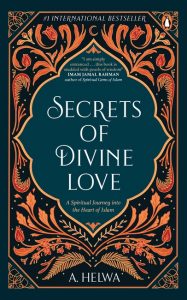
Secrets of Divine Love
Secrets of Divine Love draws upon the spiritual secrets of the Qu’ran, mystical poetry and stories from the world’s greatest prophets and spiritual masters to help you reignite your faith, overcome your doubts and deepen your connection with God. Practical exercises and guided meditations will help you develop the tools and awareness to overcome the inner critic that prevents you from experiencing God’s all-encompassing love.
Through the principles and practices of Islam, you will learn how to unlock your spiritual potential and your divine purpose. This insightful book uses a rational yet heart-based approach towards the Qu’ran that enlightens and inspires towards a deeper intimacy with God.

Believe, Sachin Tendulkar told him – and he took it to heart, getting the word etched on his arm as a tattoo.
In this book, Suresh Raina takes us through the challenges he faced as a young cricketer. He was bullied as a child, but he overcame every adversity life threw at him and never gave up. This is the story of the lessons he learnt and the friendships he built.
Peppered with invaluable insights – about the game and about life – that Raina acquired from senior colleagues, this book will make you believe in the power of hard work, love, luck, hope and camaraderie. It is a journey through the highs and lows in the career of a man who saw his world fall apart and yet became one of the most influential white-ball cricketers India has ever seen.

Salman Rushdie is celebrated as a storyteller of the highest order, illuminating truths about our society and culture through his gorgeous prose. In his latest collection of nonfiction, he brings together insightful essays and speeches that focus on his relationship with the written word and reinforce him as one of the most original thinkers of our time.
Gathering pieces written from 2003 to 2020, Languages of Truth chronicles Rushdie’s intellectual engagement with a period of momentous cultural shifts. He delves into the nature of storytelling as a human need in what emerges as a love letter to literature. Rushdie explores what the work of authors from Shakespeare and Cervantes to Samuel Beckett, Eudora Welty, and Toni Morrison mean to him. He delves deep into the nature of ‘truth’, revels in the vibrant malleability of language, the creative lines that join art and life, and looks anew at migration, multiculturalism and censorship.
Enlivened by Rushdie’s signature wit, Languages of Truth offers his piercingly analytical views on the evolution of literature and culture as he takes us on a tour of his own exuberant imagination.

On 1 October 1949, the People’s Republic of China came into being. Power moved from the hands of the nationalist Kuomintang government to the Communist Party of China headed by Mao Tse Tung. All of a sudden, it was not only a new China that India had to deal with but also a Tibet which was under increasing pressure.
Clearly, newly independent India, with Prime Minister Jawaharlal Nehru at its helm, was navigating choppy waters. Its relations with China deteriorated, eventually leading to the Indo-China war in 1962. Today, more than six decades after the war, we are still face border disputes with China that seem to routinely grab headlines. It leads one to question what exactly went on during the emergence of a new China and why have we repeatedly failed to arrive at a solution?
Based on meticulous archival research, this book analyses the events from 1949 to the Indo-China war in 1962 and its aftermath to uncover answers to these burning questions.

Tendöl Namling turned 60 in 2019. She was born at the time the Dalai Lama fled from Lhasa and the uprising of his people by the Chinese People’s Army was brutally suppressed. She lived 22 years under Chinese rule. As daughter of a high government official, she underwent the ordeal of ‘re-education’ with full force. All she had from these years are painful memories and crumpled photographs of her with friends and cousins in Lhasa, smiling as if nothing happened. When Tendöl turned 10 her brother was arrested and her mother sentenced to ten years in prison. Tendöl was sent to work in road construction for several years, following which she was allowed to start an apprenticeship as motor mechanic. Thanks to the efforts of her family in exile, Tendöl was able to leave Tibet in 1982. After twenty years of hardship she landed in prosperous Switzerland. She struggled to start her life all over again, but never gave up.
In Tendöl’s words, ‘this little book is dedicated to all the Tibetans who continue to rebel against the Chinese occupation’.

‘The Light of Asia’ is an epic poem by Sir Edwin Arnold that was first published in 1879. It quickly became a huge sensation and has continued to resonate powerfully across the world over the last century and a half. Weaving together literary, cultural, political and social history, Jairam Ramesh uncovers and narrates the fascinating story of this deeply consequential and compelling poem that has shaped our thinking of an ancient sage and his teachings. He brings into this unusual narrative the life of the multi-faceted poet himself who, among other things, was steeped in Sanskrit literature.
Sir Edwin Arnold’s English rendering of the Bhagavad Gita was one of Mahatma Gandhi’s favourites. He was also in many ways the man who may have shaped Bodh Gaya as we know it today.

A multigenerational novel of love, oppression, trauma and the pursuit of freedom, inspired in part by the author’s own family history, China Room twines together the stories of a woman and a man separated by more than half a century but united by blood.
Mehar, a young bride in the rural Punjab of 1929, is trying to discover the identity of her new husband. She and her sisters-in-law, married to three brothers in a single ceremony, spend their days working in the family’s ‘china room’, separated from the men. When Mehar develops a theory as to which of them is hers, a passion is ignited that puts more than one life at risk.
Spiralling around Mehar’s story is that of a young man who, in 1999, travels from England to a deserted farm, its ‘china room’ locked and barred. In enforced flight from the traumas of his adolescence-his experiences of addiction, racism and estrangement from the culture of his birth-he spends a summer in painful contemplation and recovery, before finally finding the strength to return home.

Padma Shri and late Hindi author Shivani’s memoirs of studying at the experimental school set up by Rabindranath Tagore, the Ashram, this charming memoir is a loving homage to a grand institution and its legendary gurus. Written from the perspective of a child, it retains the freshness and innocence of an age when experimental education was not merely a trendy movement. Shivani’s vivid pictures of the Ashram and portraits of her teachers and fellow students remain as alive as they seemed when she first wrote this memoir nearly fifty years ago.
Along with the moving tributes she wrote when some of her beloved contemporaries passed away, this slim memoir is a sort of diptych that captures the spirit of the Ashram and the liveliness of its inmates, many of whom went on to become iconic. Shivani’s recall of her time there takes the reader into an enchanted garden that remains as inspirational to her as it was when she went there a lifetime ago.

As a vocalist in the Karnatik tradition, T.M. Krishna eludes standard analyses. Uncommon in his rendition of music and his interpretation of it, Krishna is at once strong and subtle, manifestly traditional and stunningly innovative. His work is spread across the whole spectrum of music and culture, politics and the social sphere; he is at once philosophical, aesthetic and sociopolitical. He asks important questions about how art is made, performed and disseminated. Unabashedly given to rethinking classical paradigms, he addresses crucial issues of caste, class and gender with nuance and openness.
T.M. Krishna’s key writings have been put together for the first time in this extraordinary collection. The Spirit of Enquiry: Dissent as an Art Form draws from his rich body of work, thematically divided into five key sections: art and artistes; the nation state; the theatre of secularism; savage inequalities; and in memoriam. This collection reflects the critical and cultural engagement of one of our finest thinkers, public intellectuals and practitioners of art.
We know that our current times are not the most optimistic. But now more than ever, we believe that books can act as a source of hope and joy, howsoever small, and keep us going.
We have an assorted selection of books for you this May! These will keep your young ones occupied as they spend the summers indoors, inside the safety of their cozy homes.
**
All-Time Favourites for Children
Ruskin Bond

Ages: 9+ years
All Time Favourites for Children celebrates Ruskin Bond’s writing with stories that are perennially loved and can now be enjoyed in a single collectible volume. Curated and selected by India’s most loved writer, this collection brings some of the evocative episodes from Ruskin’s life, iconic Rusty, eccentric Uncle Ken, ubiquitous grandmother, and many other charming, endearing characters in a single volume while also introducing us to a smattering of new ones that are sure to be firm favourites with young readers.
Ninja Nani and the Freaky Food Festival
Lavanya Karthik

Ages: 10 to 14 years
It’s time for the annual festival and a special guest is expected to arrive in Gadbadnagar, but has a certain President gone too far? Has Nani finally met her match in the meanest, scariest and awfullest demon ever to crawl out of the Dark Forest? Will the Mayor’s mustache ever run for office?
Wait, there’s more!
Fake Mystery Heroes! Haunted falooda! Giant dogs–
And what’s that again about goats? You’re going to have to read it for yourself.
Mirror, Mirror
Andaleeb Wajid

Ages: 10 to 14 years
Five years earlier, a friend’s nasty comment makes Ananya start hating her body. She decides to change into a new person-one who effortlessly fits into all kinds of clothes, who shuns food unless it’s salad, and who can never be called ‘Miss Piggy’-and to cut everything from her ‘old’ life, including her best friend, Raghu, for being the witness to her humiliation.
Ananya is on her way to becoming the Ananya of her dreams, but she’s still a work in progress.
One day, her parents announce that they’re expecting a baby (at their age!). To make matters worse, Raghu reappears in her life …
Andaleeb Wajid’s latest novel for young adults is a touching and funny story about a young girl’s journey to acceptance and self-love.
What’s the Big Secret?
Sonali Shenoy
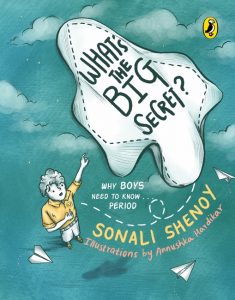
Ages: 9+ years
Eleven-year-old Aditya really wants to know about periods.
Ever since Rhea Didi began getting brown paper packages, there’s been something that no one is telling him. Mama turns red, Pa chokes on his coffee and Dadi has steam coming out of her ears! Thank goodness for his friends Naveen and Vinay-whom he can talk to.
But when Vinay brings an odd-looking napkin to school that soaks ink, Aditya is even more confused. Doesn’t his sister use a microtip pen?
All of this is only making little Aditya more determined to find out What is going on!
Dark Tales
Venita Coehlo
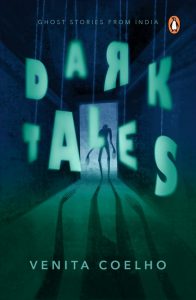
Ages: 9+ years
In this collection of eleven very dark and twisted tales, Venita Coelho lays bare the underbelly of contemporary India. Get ready to gasp and cringe in horror as you have the rug pulled out from under you! This is a book you won’t want to read after dark.
And That is Why
L. Somi Roy

Ages: 8+ years
Dear Reader, do you know
· why the deer does not eat rice?
· why man gets wrinkles and a stoop?
· why the cat buries its poop?
· why a doll is worshipped in a village called Kakching?
Discover twelve magical tales from Manipur, the mountain land in the north-east of India on the border with Myanmar. Passed down by learned scholars, balladeers and grandmothers over hundreds of years, these unknown myths and fables are enriched with beautifully rich paintings that will transport you to Manipur!
**
‘Travel far, pay no fare…A book can take you anywhere.’
– Anne Morrow Lindbergh
The portal to the rest of the world is closer to you than you think. While we advise you to physically stay at home, no one said anything about not travelling!
Penguin Random House India brings to you the #PenguinStayList – a list of books that will inform, educate and entertain you as best as they can during this pandemic. Travel around the Indian coast, up to the greatest city of the Himalayas or even to different corners of the world.
‘That’s the thing about books. They let you travel without moving your feet.’
– Jhumpa Lahiri
Following Fish : Travels around the Indian Coast
In a coastline as long and diverse as India’s, fish inhabit the heart of many worlds food of course, but also culture, commerce, sport, history and society. Journeying along the edge of the peninsula, Samanth Subramanian reports upon a kaleidoscope of extraordinary stories. Throughout his travels, Subramanian observes the cosmopolitanism and diverse influences absorbed by India’s coastal societies, the withdrawing of traditional fishermen from their craft, the corresponding growth of fishing as pure and voluminous commerce, and the degradation of waters and beaches from over-fishing.
Don’t Ask Any Old Bloke For Directions – A Biker’s Whimsical Journey Across India
After twenty years in the Indian Administrative Service, P.G. Tenzing throws off the staid life of a bureaucrat to roar across India on an Enfield Thunderbird, travelling light with his possessions strapped on the back of his bike. On the nine-month motorcycle journey without a pre-planned route or direction, he encounters acquaintances who appear to be from his karmic past: from the roadside barber to numerous waiters and mechanics― fleeting human interactions and connections that seem pre-ordained.
If It’s Monday It Must Be Madurai: A Conducted Tour Of India
This book was first written when author Srinath Perur made the mistake of going on a conducted tour of ten of the most famous sites in India. However, despite being very annoyed at his bovine compatriots and his sonorous tour-guide, he found that there was some merit in traveling in groups, and wrote down his experiences in the form of this book. Witty, Humorous, and insightful, it combines his science-based knowledge and heartfelt experiences to create a tableau of interesting descriptions and adventures.
Shooting Star, The: A Girl, Her Backpack and the World
Shivya Nath quit her corporate job at age twenty-three to travel the world. She gave up her home and the need for a permanent address, sold most of her possessions and embarked on a nomadic journey that has taken her everywhere from remote Himalayan villages to the Amazon rainforests of Ecuador. Along the way, she lived with an indigenous Mayan community in Guatemala, hiked alone in the Ecuadorian Andes, got mugged in Costa Rica, swam across the border from Costa Rica to Panama, slept under a meteor shower in the cracked salt desert of Gujarat and learnt to conquer her deepest fears.
Travel Gods Must Be Crazy, The: Wacky Encounters in Exotic Lands
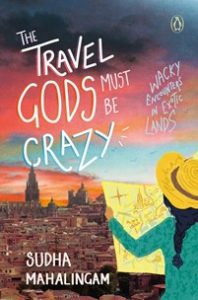
Dreaming of glorious sunrises and architectural marvels in exotic places, Sudha often landed up in situations that were uproariously bizarre or downright dangerous. Tongue firmly in cheek, she recounts her journeys through the raw wildernesses of Borneo and the African savannah, into the deserts of Iran and Uzbekistan, and up the Annapurna and the Pamirs, revealing the quirky side of solo travel to side-splitting effect. Punctuating her droll stories with breathtaking descriptions and stunning photographs, Sudha invites readers on an unexpected and altogether memorable tour around the world!
Kathmandu
Kathmandu is the greatest city of the Himalayas a unique survival of cultural practices that died out in India 1000 years ago. It is a carnival of sexual license and hypocrisy, a jewel of world art, a hotbed of communist revolution, a paradigm of failed democracy, a case study in bungled Western intervention and an environmental catastrophe.
Kathmandu follows the author’s story over a decade in the city and unravels the city’s history through successive reinventions of itself. Erudite, entertaining and accessible, this is the distinctive chronicle of a fascinating city.
From Heaven Lake
Hitch-hiking, walking, slogging through rivers and across leech-ridden hills, Vikram Seth travelled through Sinkiang and Tibet to Nepal: from Heaven Lake to the Himalayas, By breaking away from the reliable routes of organized travel, he transformed his journey into an unusual and intriguing exploration of one of the world’s least-known areas.
The Other Side of the Divide
Pegged on journalist Sameer Arshad Khatlani’s visit to Pakistan, this book provides insights into the country beyond what we already know about it. These include details on the impact of India’s soft power, thanks to Bollywood, and the remnants of Pakistan’s multireligious past, and how it frittered away advantages of impressive growth in the first three decades of its existence by embracing religious conservatism.
The book attempts to present a contemporary portrait of Pakistan-where prohibition remains only on paper and one of the biggest taxpayers is a Parsee-owned brewery-as a complicated and conflicted country suspended between tradition and modernity.
Well, that’s our list. Where will you travel to first?
Satyajit Ray hardly needs an introduction. Regarded as one of the greatest film-makers of our times, he received the Oscar for Lifetime Achievement by the Academy of Motion Picture Arts and Sciences in 1992 and was honoured with the Bharat Ratna in the same year.
He was also an ace designer, illustrator, music composer and to celebrate 100 years of the man, we share a list of books by him you’re bound to love, whether you’re new to his work, or are a long-term appreciator.
Childhood Days
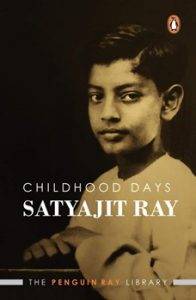
Childhood Days is a biography of Satyajit Ray, which he wrote on his own. Through this book, readers will come to know about the people who were around him during his childhood years, where he spent the early years of his life and who Satyajit Ray was, the man who we now know as an artist, music composer, director and writer. This book enables readers to take a look at a different side of Satyajit Ray, which is affectionate, tender and humorous, quite different from the person everyone knows, who is a serious man who keeps himself isolated from the world.
Classic Satyajit Ray
Ray’s short stories often explore the macabre and the supernatural, and Gopa Majumdar marked by the Translated from the Bengali by the author and are sharp characterization and trademark wit that characterizes his films. Cover illustration by Isa Esai This collection brings together Ray’s best short stories – including such read more timeless gems as ‘Khagam’, ‘Indigo’, ‘Fritz’, ‘Bhuto’, ‘The Pterodactyl’s Egg’, ‘Big Bill’, ‘Patol Babu, Film Star’ and ‘The Hungry Septopus’ – which readers of all ages will enjoy.
The Collected Short Stories (City Plans)
Best known for his immensely popular Feluda mysteries and the adventures of Professor Shonku, Satyajit Ray was also one of the most skilful short story writers of his generation. Ray’s short stories often explore the macabre and the supernatural, and are marked by the sharp characterization and trademark wit that distinguishes his films. This collection brings together Ray’s best short stories—including such timeless gems as ‘Khagam’, ‘Indigo’, ‘Fritz’, ‘Bhuto’, ‘The Pterodactyl’s Egg’, ‘Big Bill’, ‘Patol Babu, Film Star’ and ‘The Hungry Septopus’—which readers of all ages will enjoy.
My Years With Apu
The Indian film-maker Satyajit Ray tells the story behind the making of his three films, the “Apu” trilogy. Completed shortly before his death, the memoir covers the key aspects of his career: his decision to give up a lucrative job in advertising in order to make his first film, early setbacks, a chronic shortage of funds, the guidance and support of directors such as Jean Renoir, his solutions to problems, and the acclaim for his films at home and abroad.
Speaking of Films
Exactly fifty years ago, in 1955, the release of Pather Panchali heralded the arrival of a master in the world of cinema. Over the next forty years, Satyajit Ray came to be regarded as one of the world’s finest film-makers ever. Speaking of Films brings together some of Ray’s most memorable writings on film and film-making. With the masterly precision and clarity that characterize his films, Ray discusses a wide array of subjects: the structure and language of cinema with special reference to his adaptations of Tagore and Bibhuti Bhushan Bandopadhyay, the appropriate use of background music and dialogue in films, the relationship between a film-maker and a film critic, and important developments in cinema like the advent of sound and color. He also writes about his own experiences, the challenges of working with rank amateurs, and the innovations called for when making a film in the face of technological, financial and logistical constraints.
Indigo
Spine-tingling tales from the other side of midnight. Indigo is the mood in this new collection of stories about the supernatural, the peculiar and the inexplicable from Satyajit Ray, one of the best-loved writers of our times. There are tales here of dark horror, fantasy and adventure along with heartwarmingly funny stories about ordinary people in extraordinary situations. Indigo is a veritable treasure trove especially for those who like a taste of the unusual in a short story and an unexpected twist at the end. Translated from the Bengali by the author and Gopa Majumdar.
The Complete Adventures of Feluda Vol. 1
This omnibus edition features the ever-popular adventures of Satyajit Ray’s enduring creation, the professional sleuth Pradosh C. Mitter (Feluda). In his escapades, Feluda is accompanied by his cousin Topshe and the bumbling crime writer Lalmohan Ganguly (Jatayu). From Jaisalmer to Simla, from the Ellora Caves to Varanasi, the trio traverse fascinating locales to unravel one devious crime after another.
The Complete Adventures of Feluda Vol. 2
For readers who enjoyed The Adventures of Feluda in Volume 1, this second omnibus volume holds more delights. Accompanied by his cousin Topshe and the bumbling crime writer Lalmohan Ganguly (Jatayu), Feluda travels from Puri to Kedarnath, from Kathmandu to London in his pursuit of culprits; he tracks down Napoleon’s last letter, a forgotten painting by Tintoretto and a stolen manuscript.